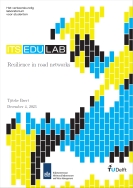The resilience of a road network indicates the magnitude and consequences of a disruption, which can be events such as a traffic accident or a flood. The literature is not in agreement about the exact definition of road network resilience, and the way to quantify it. A literature search was done to look for definitions and resilience metrics. Eleven metrics were found that quantify resilience in road networks to accidents. These eleven metrics are compared based on whether they are on a network level, and how many variables are used. Two metrics are chosen, one based on travel time, and one based on space-mean flow. Another metric, based on the outflow of the network is added.
The three chosen metrics are then compared in small networks to see if they give the same results. The small network consist of five nodes with different link configurations. The conclusion about which network is the most resilient changes with the resilience metrics. The metric based on travel time is deemed the best for this type of research. The metric based on network outflow can have distorted results due to high peaks, and the metric based on space-mean flow is better suited for a different experiment design.
To see how network parameters such as link density influence the resilience, a simulation with random networks was done. In total 266 networks with nine nodes in random locations, and random links between them, were simulated. It is concluded that networks with a lower link density have a higher resilience. This is not only illustrated by the relation between resilience and link density, but also by several other network parameters which are related to link density such as average number of lanes and connectivity. A reason that these networks are more resilient could be that there is less spillback. The links in the high density networks are longer and have more lanes, so congestion will not spread to other links as fast.
